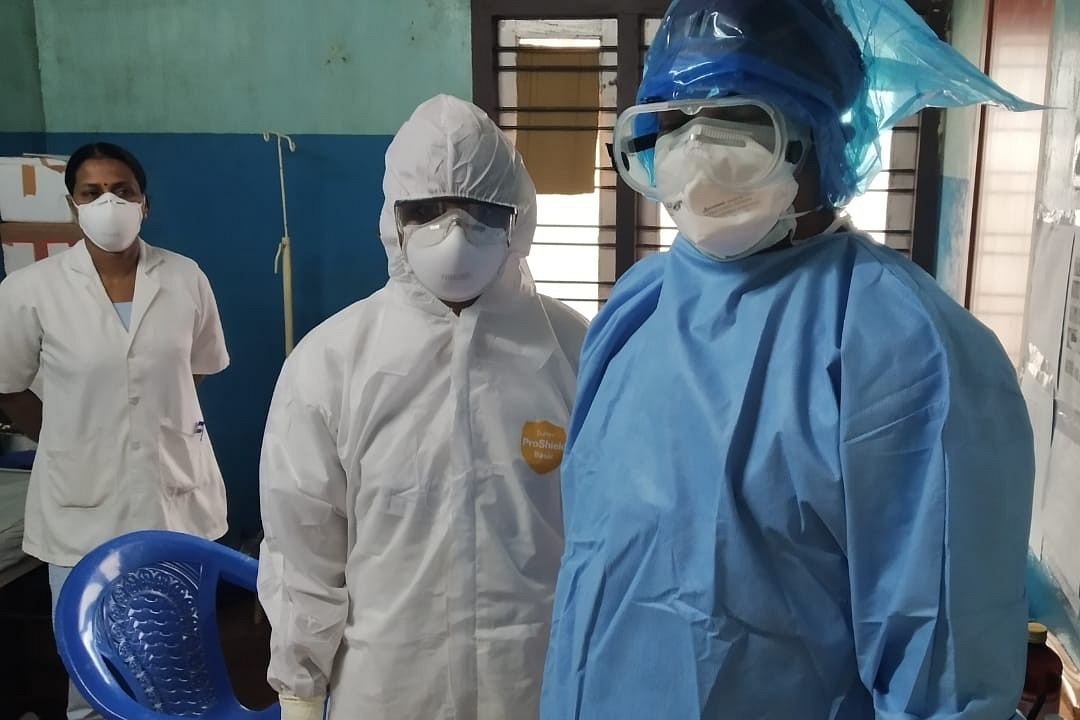News Brief
Black Fungus Infection: Govt Releases Advisory On Management Of Mucormycosis In Covid-19 Patients

Healthcare workers in Kerala wearing PPE (Wikimedia Commons)
The Union government on Sunday (9 May) released an advisory for screening, diagnosis, and management of mucormycosis or ‘black fungus’ infection that is being widely reported among COVID-19 survivors in the country.
Mucormycosis (previously called zygomycosis) is a serious but rare fungal infection caused by a group of molds called mucormycetes. These molds live throughout the environment. Mucormycosis mainly affects people who have health problems or take medicines that lower the body's ability to fight germs and sickness.
"Mucormycosis, if uncared for, may turn fatal. Sinuses or lungs of such individuals get affected after fungal spores are inhaled from the air," it said.
Warning signs and symptoms of Mucormycosis
- Pain and redness around eyes and nose
- Fever
- Headache
- Coughing
- Shortness of breath
- Bloody vomits
- Altered mental status
What are the predispositions?
- Uncontrolled diabetes mellitus
- Immunosuppression by steroids
- Prolonged ICU stays
- Co-morbidities – post-transplant/malignancy
- Voriconazole therapy
When to suspect Mucormycosis
- Sinusitis – nasal blockade or congestion, nasal discharge (blackish/bloody), local pain on the cheek bone One-sided facial pain, numbness or swelling
- Blackish discoloration over bridge of nose/palate
- Toothache, loosening of teeth, jaw involvement
- Blurred or double vision with pain; fever, skin lesion; thrombosis & necrosis (eschar)
- Chest pain, pleural effusion, haemoptysis, worsening of respiratory symptoms
What should you do?
- Use masks if you are visiting dusty construction sites
- Wear shoes, long trousers, long sleeve shirts and gloves while handling soil (gardening), moss or manure
- Maintain personal hygiene, including thorough scrub bath
- The disease can be managed by controlling diabetes, discontinuing immunomodulating drugs, reducing steroids and extensive surgical debridement- to remove all necrotic materials, according to the advisory.
Dos
- Control hyperglycemia
- Monitor blood glucose level after COVID-19 recovery and also in diabetics
- Use steroid judiciously – correct timing, correct dose and duration
- Use clean, sterile water for humidifiers during oxygen therapy
- Use antibiotics/antifungals judiciously
Don’ts
- Do not consider all the cases with a blocked nose as cases of bacterial sinusitis, particularly in the context of immunosuppression and/or COVID-19 patients on immunomodulators
- Do not hesitate to seek aggressive investigations, as appropriate (KOH staining & microscopy, culture, MALDITOF), for detecting fungal aetiology
- Do not lose crucial time to initiate treatment for mucormycosis
Management of Mucormycosis
- Control diabetes and diabetic ketoacidosis
- Reduce steroids (if patient is still on) with aim to discontinue rapidly
- Discontinue immunomodulating drugs
- No antifungal prophylaxis needed
- Extensive Surgical Debridement - to remove all necrotic materials
- Monitor patients clinically and with radio-imaging for response and to detect disease progression
- Medical Treatment:
- Install peripherally inserted central catheter (PICC line)
- Maintain adequate systemic hydration
- Infuse normal saline IV before Amphotericin B infusion
- Antifungal therapy, for at least 4-6 weeks (follow guidelines)
Whom should you consult?
- Microbiologist
- Internal Medicine Specialist
- Intensivist Neurologist
- ENT Specialist
- Ophthalmologist
- Dentist Surgeon (maxillofacial/plastic)
- Biochemist
Introducing ElectionsHQ + 50 Ground Reports Project
The 2024 elections might seem easy to guess, but there are some important questions that shouldn't be missed.
Do freebies still sway voters? Do people prioritise infrastructure when voting? How will Punjab vote?
The answers to these questions provide great insights into where we, as a country, are headed in the years to come.
Swarajya is starting a project with an aim to do 50 solid ground stories and a smart commentary service on WhatsApp, a one-of-a-kind. We'd love your support during this election season.
Click below to contribute.
Latest